These Gorgeous Andalusian Gardens Will Have You Packing Your Bags For Spain
Touring the region's palaces, patios and paradise gardens was a great way to learn about Spanish culture.
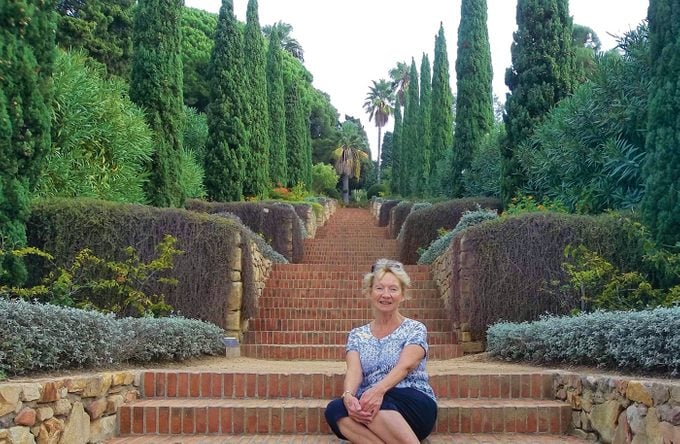
A Whirlwind Tour of Spanish Gardens
Spain conjures images of white-washed villages, bullfights and fiery flamenco, but have you discovered her gardens? On a recent soujourn in Andalusia with master gardener Donna Dawson and tour operator/leader Jonathan Lord, Spanish gardens enchanted with their diversity and aesthetic beauty. Our tour proved rich in history and culture, as Spanish gardens are an essential element of streetscapes, palaces, mosques and stately patrician homes.
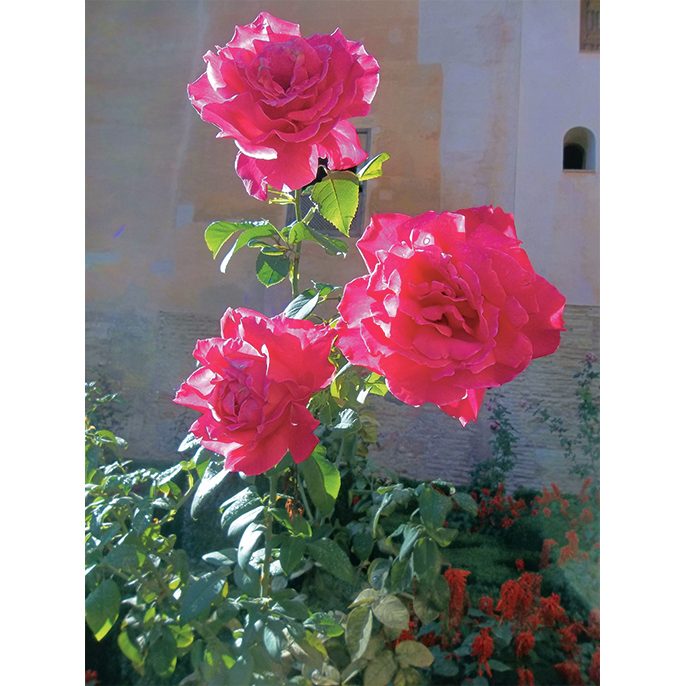
Granada
Since Senorita Gilbert’s high-school Spanish class, I’ve dreamed of the Alhambra palace, an ancient fortress located in Granada, Andalusia. The palace, formerly a stronghold of Moorish rule, remains an outstanding example of medieval architecture, a testament to the role of nature in the everyday life of Islam. The Iberian Peninsula flourished under Muslim rule for almost 800 years and their influence runs deep.
According to Islamic tradition, the courtyard—a walled or enclosed garden—depicts the Quran’s symbol of paradise, while the Alhambra’s fountains and reflecting pools provide solace. The Courtyard of the Lions, with its 12 marble lions representing royalty and power, stands as a focal point of respite in the sultan’s private dwellings.
As I climb terraced slopes on walkways paved with a mosaic of river pebbles, passing cypress hedges, velvet roses, and lemon, orange and pomegranate trees, I was entranced as we reached the Generalife—the sultan’s summer palace and retreat. Within the walls of the Generalife are two major courtyards, The Courtyard of the Cypress, considered the best-preserved medieval Persian garden in Europe. Inside the complex, lies the The Water Garden Courtyard—a long pool with tinkling fountains framed by flowerbeds and colonnades.
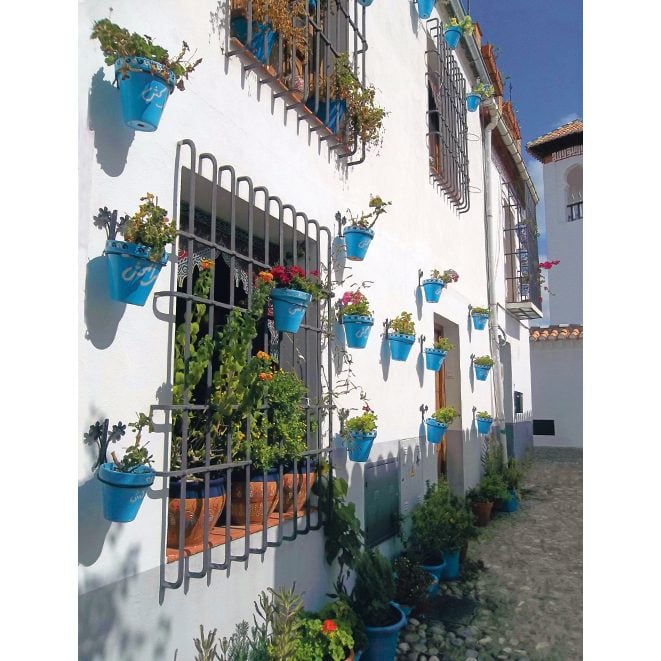
Cordoba
In Cordoba, wandering the Alcazar’s majestic formal gardens, I can imagine the respite Queen Isabella found as she sat and read among the palms, fountains and neatly trimmed boxwood.
At the Mesquita/Great Mosque, a UNESCO World Heritage Site, I learn that the concept of a mosque originated as Mohammed and his followers met for prayer under date palms for protection from the scorching sun. The forest of columns strikes me as the most captivating feature of this sacred place. For three centuries, the Great Mosque of Cordoba held a place of importance for the Islamic community of Al-Andalus. It is from Al-Andalus that Spain’s southern region takes its name Andalusia.
A courtyard, fundamental to any mosque, functions as a place for ritual purification. At the Mezquita, the Courtyard of the Orange Trees with its palms, orange trees and bubbling fountain, not only serves this purpose but an aesthetic one, too.
The Moors ruled the Iberian Peninsula from 711 AD to 1492 until the Reconquista. It was their custom to carry a small bit of nature. From this ancient belief sprang the potted plant. In Cordoba bright blue pots with colourful plants climb whitewashed city walls, creating vertical “gardens in the sky.” In a central square, I come upon a whimsical sculpture of a young woman painstakingly watering each individual pot.
Every year for 12 days in May, Cordoba celebrates the Festival of the Patios. The festival consists of 50 flower-filled patios and terraces, from small private houses to grand mansions and religious institutions, which open up to visitors as part of the competition. Countless pots create a dazzling tapestry of blooms. Many feature climbing and hanging plants, with fragrant blossoms, creating a virtual feast for the senses.
Spaces known as the megaron in ancient Greece and the atrium in Rome were open courtyards within the house, serving as a place to socialize and enjoy intimate family space. The key elements then as today include clay pots, vines, fruit trees, wrought iron grates, ceramic tile and a water feature. Water offers an oasis in torrid summer and its murmur is a sweet song.
The Palacio de los Viana, home to many noble families between the 15th to 20th centuries, remains a private residence with a dozen unique patio gardens open to the public. Some stunning plant material found in their designs include scented jasmine, pink oleander, blue plumbago, lemon and pomegranate trees.
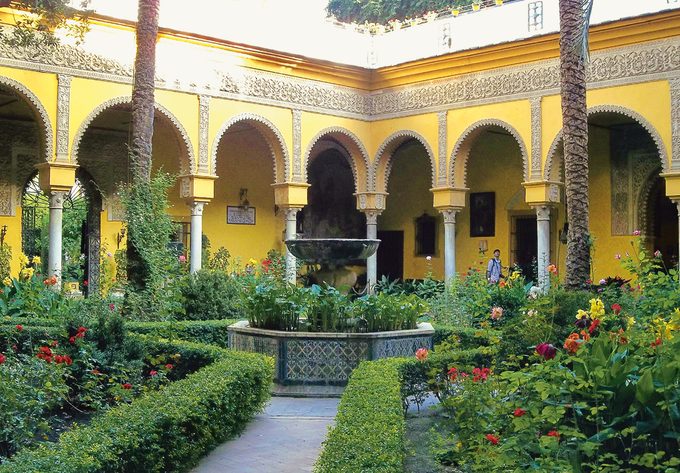
Seville
The bougainvillea-covered Palacio de las Duenas, palatial home of the Duchess of Alba, opened in 2016 after her passing. Today it’s a museum with exquisite Mudejar patios. Lavishly furnished rooms decorated with fine art, antiques, marble sculptures and Flemish tapestries surround a huge central courtyard. Six smaller courtyards sit off the grand central courtyard with its palms, roses, boxwood allees and giant kapok tree.
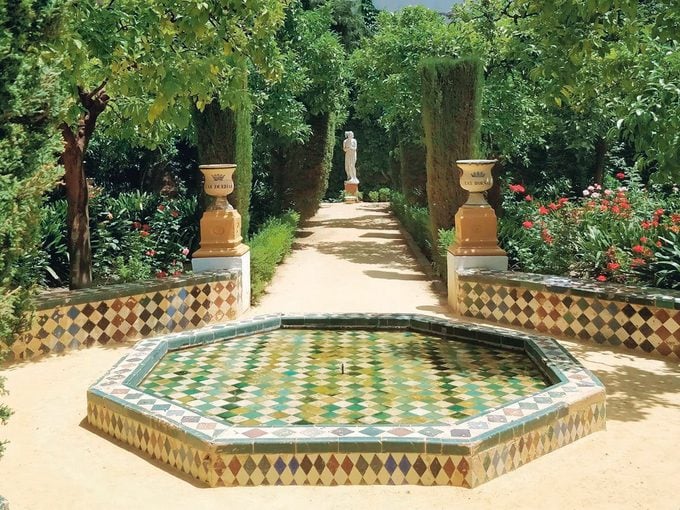
Maria Luisa Park in Seville, which I yearn to see from a horse-drawn carriage, supplies a welcome green space acting as lungs for this thriving city of 705,000. It reminds me of Central Park in New York. The area is designed in Moorish paradisiacal style with ponds, fountains, lush plantings, Mediterranean pines, stylized flower beds and hidden vine-covered bowers. Not only is the park a botanical garden, it’s home to doves, ducks, swans and parakeets. The statue of poet Becquer and the octagonal fountains of lions and comical frogs spouting water provide interest and entertainment.
The Plaza de Espana, built for the 1929 Spanish American Exhibition, is a brilliant landmark in the North West area of Maria Luisa Park. Venetian foot bridges with bright blue azulejo-tiled handrails cross canals, and colourful balustrades depict a historical scene from each province.
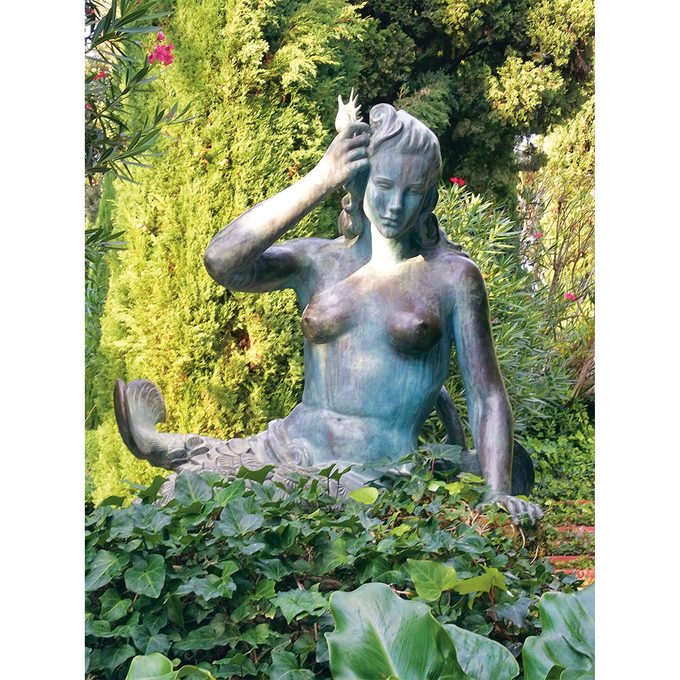
Beyond Barcelona
Barcelona is renowned for Gaudi’s modernisme architecture, but did you know that an hour outside of the city, you can discover two unique Spanish gardens—Santa Clotilde and Marimurtra? What a highlight for the close of our spectacular trip! The Botanical Gardens of Santa Clotilde designed in 1919 by Catalan architect and landscaper Nicolau Rubió i Tuduri recreate the spirit of the Italian Renaissance. Commissioned by the Marquis de Roviralta and named for his wife, the palette is mostly green except in spring when mauve wisteria covers the arches and blue viola interlaces with ivy.
Perched high on a cliff overlooking the rocky Costa Brava, Santa Clotilde is classical in design and symmetry. This garden reflects order and beauty and stands in juxtaposition to the rugged cliffs and raging sea below. Mediterranean species predominate—pines, cypress, cedars and myrtle hedges. Steps lined with ivy give the impression of a grand waterfall and lead to a spectacular viewpoint. I’m mesmerized by Maria Llimona’s Stairway of Sirens, comprising sculptures of beguiling, bronze mermaids with their seashell scales and beauty bewitching mariners and gardeners alike.
Marimurtra Botanical Gardens, created in 1924 by German businessman Karl Faust, houses over 4,000 species of exotic plants from five continents and represents tropical, temperate and Mediterranean climates. Finely trimmed myrtle hedges line the steep cliffs running along the Mediterranean, giving the garden its name: Mari (sea) Murtra (myrtle). From the Linnaeus Temple, I feel the force of the sea crashing on the rocky cliffs, in contrast to man’s cultivated garden. Can we tame nature?
On this adventure, I experienced Spain’s culture and history through her gardens. In their infinite variety, Spanish gardens inspire—offering respite, reflection and a sense of wonder.
For horticultural highlights much closer to home, check out Canada’s must-visit botanical gardens.






